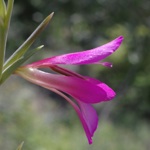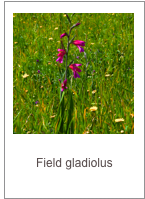Gladiolus illyricus
Greek gladiolus Γλαδιόλα

Iridaceae - the Iris Family Monocot.
Gladiolus illyricus
Greek gladiolus Γλαδιόλα

Iridaceae - the Iris Family Monocot.
The beautiful wild gladioli brighten up the olive groves and roadsides with their sword-like leaves and attractive magenta flowers. G. illyricus is probably the true wild species of gladiolus on Skopelos and is widespread in the countryside. The wild gladiolus, including the colour, is somewhat more delicate than the field gladiolus, but the main difference is the structure of the seeds.
It is probably the flower of the ancient Greek myth of Hyacinth (Υάκινθος) and it was said that the ancient Greek letter Y,the first letter of his name was written on the petals; with a little imagination that can be observed.



Gladiolus from gladius - Latin for sword
Illyrius meaning from Illyria (Ἰλλυρία) in ancient times the West of Balkan Penisular



The Ancient Myth of Hyacinthus.
Υάκινθος
The Spartan Prince, Hyacinthus is said to have been the first human to have been loved by another man, the poet, Thamyris. But Thamyris was not the only one, the god Apollo and the West Wind had also fallen in love with the beautiful youth and Apollo spent time with him, teaching him how to hurl a discus. The West Wind became insanely jealous and caught the discus in midair and dashed it against Hyacinthus's head, killing him. His blood was spattered across the field and a flower sprang up where each drop had landed. The first letter of his name were written on the petals of the flowers.